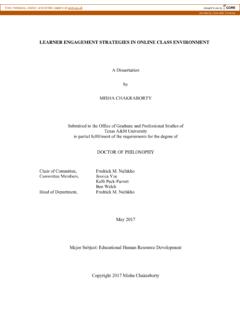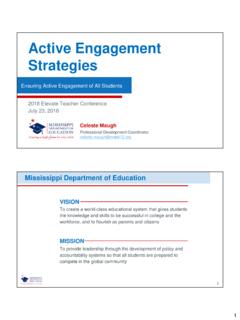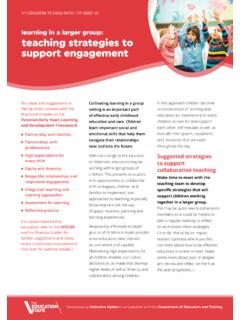Transcription of Engagement Matters: Student Perceptions on the Importance ...
1 Engagement Matters: Student Perceptions on the Importance of Engagement strategies in the Online Learning Environment Online Learning Journal Volume 22 Issue 1 March 2018 205 Engagement Matters: Student Perceptions on the Importance of Engagement strategies in the Online Learning Environment Florence Martin University of North Carolina Charlotte Doris U. Bolliger University of Wyoming Abstract Student Engagement increases Student satisfaction, enhances Student motivation to learn, reduces the sense of isolation, and improves Student performance in online courses.
2 This survey-based research study examines Student perception on various Engagement strategies used in online courses based on Moore s interaction framework. One hundred and fifty-five students completed a 38-item survey on learner-to-learner, learner-to-instructor, and learner-to-content Engagement strategies . Learner-to-instructor Engagement strategies seemed to be most valued among the three categories. Icebreaker/introduction discussions and working collaboratively using online communication tools were rated the most beneficial Engagement strategies in the learner-to-learner category, whereas sending regular announcements or email reminders and providing grading rubrics for all assignments were rated most beneficial in learner-to-instructor category.
3 In the learner-content category, students mentioned working on real-world projects and having discussions with structured or guiding questions were the most beneficial. This study also analyzed the effect of age, gender, and years of online learning experience differences on students perception of Engagement strategies . The results of the study have implications for online instructors, instructional designers, and administrators who wish to enhance Engagement in the online courses.
4 Keywords: online learning, asynchronous, Engagement , Student perception Martin, F. & Bolliger, (2018). Engagement matters: Student Perceptions on the Importance of Engagement strategies in the online learning environment. Online Learning 22(1), 205-222. Engagement Matters: Student Perceptions on the Importance of Engagement strategies in the Online Learning Environment Engagement is crucial to Student learning and satisfaction in online courses. The definition of Engagement has been extensively explored in distance and online learning literature for decades.
5 Student Engagement is defined as the Student s psychological investment in and effort directed Engagement Matters: Student Perceptions on the Importance of Engagement strategies in the Online Learning Environment Online Learning Journal Volume 22 Issue 1 March 2018 206 toward learning, understanding, or mastering the knowledge, skills, or crafts that academic work is intended to promote (Newmann, Wehlage, & Lamborn, 1992, p. 12). Student Engagement in online learning is very important because online learners seem to have fewer opportunities to be engaged with the institution.
6 Hence, it is essential to create multiple opportunities for Student Engagement in the online environment. The need for Engagement has resulted in the development of guidelines for designing effective online courses (Roblyer & Ekhaml, 2000). Engagement strategies are aimed at providing positive learner experiences including active learning opportunities, such as participating in collaborative group work, having students facilitate presentations and discussions, sharing resources actively, creating course assignments with hands-on components, and integrating case studies and reflections.
7 Banna, Lin, Stewart, and Fialkowski (2015) stress that Engagement is the key solution to the issue of learner isolation, dropout, retention, and graduation rate in online learning. Meyer (2014), Banna et al. (2015), and Britt (2015) assert the Importance of Student Engagement to online learning because they believe Student Engagement can be shown as evidence of students considerable effort required for their cognitive development and their given ability to create their own knowledge, leading to a high level of Student success.
8 According to Banna et al. (2015), if content played a central focus in the past, Engagement plays an important role in stimulating online learning today. To boost Student Engagement , three basic Engagement techniques of online learning have been identified: Student -content, Student -instructor, and Student - Student (Bernard et al., 2009). Lear, Ansorge, and Steckelberg (2010) say that interactions with content, peers, and instructors help online learners become active and more engaged in their courses. Interactivity and sense of community result in high-quality instruction and more effective learning outcomes.
9 Review of Related Literature Framework Interaction and Engagement are closely related and even used interchangeably. Student Engagement is developed through interaction (Anderson, 2003), and fostering interaction is important in online learning. On reviewing research in the higher education context, Chickering and Gamson (1987) proposed a framework to ensure students Engagement : Seven Principles for Good Practice in Undergraduate Education. The seven principles identified in this framework list that students are more engaged when the instruction (1) increases the contact between Student and faculty, (2) provides opportunities for students to work in cooperation, (3) encourages students to use active learning strategies , (4) provides timely feedback on students academic progression, (5) requires students to spend quality time on academic tasks, (6) establishes high standards for acceptable academic work, and (7)
10 Addresses different learner needs in the learning process. Several of these seven principles apply to the online learning environment even though they were proposed for the face-to-face classroom. Moore (1993) identified three types of interaction inherent in effective online courses: (1) learner-to-learner interaction, (2) learner-to-instructor interaction, and (3) learner-to-content interaction. This was used as the guiding framework for this study (see Figure 1). Lear et al. (2010) found that interactions with peers, instructors, and content help online learners become active and more engaged in their courses.



















